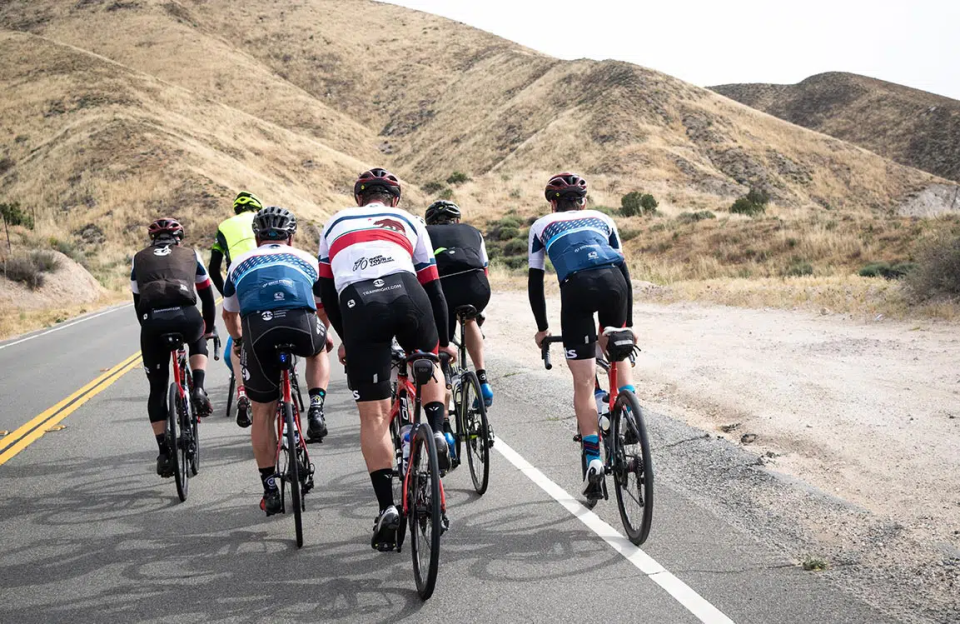Cycling in Wind: Skills for Solo Riding and Drafting
By Chris Carmichael, Founder and Head Coach of CTS
I grew up in south Florida, lived in Belgium, and raced in the Netherlands. I learned a thing or two about cycling in wind, so it pains me to see cyclists make mistakes because they don’t understand the dynamics of cycling on a windy day. Sometimes it’s just because they haven’t mastered cycling skills or how to draft. Whether you’ve been riding for 20 years or you just got started, save yourself some anguish with these tips.

Tailwind ≠ Easy
When you are riding by yourself, a tailwind is a blessing. When you’re in a pace line or a peloton it can be anything but easy. The benefit of drafting is that you have less air resistance to fight through compared to the front riders. The problem with a tailwind is that it reduces the net air resistance for the riders at the front of the pack. When they can go faster, the benefit of drafting decreases and everyone has to work hard. You get less recovery sitting on the wheel.
Tailwinds are hot
Air flowing over your body is crucial for evaporative cooling. Riding into a headwind increases the speed of air flowing over your body, which is why you can get cold in a headwind. In contrast, you can overheat in a tailwind because the net airflow over your body decreases as the difference between your speed and the wind speed decreases.
During the summer it is important to focus on hydration during prolonged tailwinds because you’re going to be sweating a lot. In cool weather it’s important to open up your layers in a tailwind so you can keep your clothing drier. When you turn into a headwind with sweat-soaked layers you will get cold very quickly. If you have a jacket or vest, reserve it for the headwind.
You can’t overpower a headwind
Picking a fight with a headwind is one of the biggest mistakes riders make. You can’t win that fight; the harder you go the faster you wear yourself out. Think about it this way: if your maximum sustainable climbing power is 265 watts, you don’t magically get more powerful with the wind in your face. Nevertheless, riders push 300 watts into the wind in an effort to maintain the speed that feels normal for that terrain. That only lasts a few minutes, and then the wind wins.
If you’re going to be cycling in wind by yourself for a long time, let go of your expectations of maintaining a specific pace. Don’t let the relentless noise or push of the wind in your face provoke you into pushing harder than you can sustain. Focus on your power output and/or perceived exertion and stay steady.
Be smart in a crosswind
Getting into a good position in a headwind is checkers; positioning in a crosswind is chess. An echelon is a thinking person’s pace line, because you have to constantly adjust your position relative to the rider on your windward side and the lane or road is always narrower than the number of riders you have in the group.
Anticipation is the key to success in crosswinds. In particular, you have to anticipate that the crosswind is coming and get into position before you reach it. If you’re out of position when you turn into the crosswind, it may be too late to get into the first echelon. And even if you can fight your way into the first echelon, it’s going to require a lot more work to get there.
When you take a pull in a crosswind, pull off into the wind and then drop back across the group quickly. Don’t dawdle out there in the wind. Similarly, if you don’t make the first echelon, start a second one immediately. Don’t fight in the gutter for a nonexistent draft. Set up the second echelon before a gap opens to the first group.
Watch out for wind gusts
A strong and steady wind can be a pain, but cycling in gusty winds can be downright scary – especially on descents. Getting in the drops and low on the bike can help you maintain stability and steering control by pressing more weight onto the front wheel and allowing you to use more upper body strength to keep your wheel straight. It’s also important to keep pedaling in gusty winds to maintain forward momentum and counter the force from the side. If you’re coasting when the gust hits you from the side, it will be harder to stay on your line.
In Florida, the Netherlands, and any flat place known for strong crosswinds, pay attention to gaps between buildings or areas that transition from protected to open. If the wind gusts are coming from the left and you’re riding on the right side of the road, don’t hug the side of the road. Give yourself some room on your right in case the wind moves you over a few feet.
The above is a short excerpt from the full CTS TrainRight article, to read the full article, please visit: https://trainright.com/cycling-in-wind-solo-drafting
